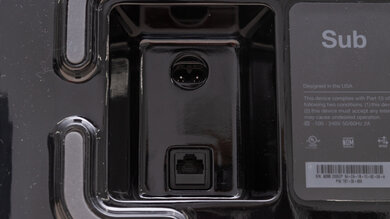The LG SPD7Y is a 3.1.2 setup released in 2021. It can get pretty loud, and it comes with lots of EQ presets to help you customize its sound. While it has a boomy sound profile on its 'Standard' preset, you can use its bass and treble adjustments to create a more neutral sound if you prefer. It also supports Dolby Atmos and surround content, though it doesn't offer a very immersive listening experience.
Our Verdict
The LG SPD7Y soundbar is satisfactory for mixed usage. Out-of-the-box, it has a boomy sound profile that can make your audio seem a bit muddy and dark. Fortunately, there are bass and treble adjustments to help you customize its sound more to your liking. It gets loud, and it also supports Dolby Atmos content. While it supports surround content, too, it has to downmix it to stereo, which doesn't sound as immersive.
- Gets loud.
- Bass and treble adjustments.
- No graphic EQ.
- Lacks some low-bass.
The LG SPD7Y soundbar is good for dialogue-centric content like TV shows. Thanks to its discrete center channel, it can accurately localize voices to a pinpoint location in the sound image. Its balanced mid-range can reproduce dialogue clearly, though it can also sound a bit muddy and dark. You can also use its dialogue enhancement feature to make voices more clear and crisp, or its auto-volume mode to balance the volume level across different programs.
- Dialogue enhancement feature.
- Bluetooth-enabled.
- No Wi-Fi, AirPlay, or Chromecast built-in support.
The LG SPD7Y soundbar is satisfactory for music. On its 'Standard' preset, it has a boomy, bass-heavy sound profile that can make audio sound a bit muddy and dark. Fortunately, it comes with bass and treble adjustments that you can use to create a more neutral sound if you prefer. It also gets pretty loud, and there isn't a lot of compression when you push it to max volume, so audio reproduction is clean. However, it still struggles to reproduce an extended low-bass, so you don't feel the deep rumble in bass-heavy genres like EDM.
- Gets loud.
- Bass and treble adjustments.
- No graphic EQ.
- Lacks some low-bass.
The LG SPD7Y soundbar is decent for movies. It supports Dolby Atmos content, using its two up-firing drivers to bounce sound off the ceiling to create the illusion of height. It also supports surround content, but unfortunately, it has to downmix it into stereo to play it, which isn't as immersive. It also struggles to reproduce an extended low-bass, so you don't feel the deep rumble in action scenes and movie scores.
- Gets loud.
- Lacks some low-bass.
Changelog
- Updated Dec 14, 2023: Added market comparison to the LG SP7R to the Style - Satellites box.
- Updated Aug 11, 2021: Review published.
- Updated Aug 05, 2021: Early access published.
- Updated Aug 02, 2021: Our testers have started testing this product.
Check Price
Differences Between Sizes And Variants
The LG SPD7Y soundbar comes in 'Black', and you can see the label for the model we tested here.
If you come across another version of this soundbar, please let us know in the discussion section below so we can update our review.
Popular Soundbar Comparisons
The LG SPD7Y soundbar is a mid-range 3.1.2 setup released in 2021. Unlike the LG SP7Y, it comes with two up-firing drivers for Dolby Atmos content. However, it lacks some more premium sound enhancement features, like AI Room Calibration or the 2021 LG TV AI Processor. It also has a boomy, dark sound profile out-of-the-box, which may not be ideal for all listeners. See also our recommendations for the best soundbars under $500, the best Dolby Atmos soundbars, and the best LG soundbars.
The Sonos Arc is a better soundbar than the LG SPD7Y. The standalone Sonos is better built and has better soundstage, center, surround, and Atmos performances. It also has a more neutral sound profile with its room correction feature, which some users may prefer. It also has built-in voice assistant support. However, the LG has EQ presets for sound customization and a Full HDMI In port.
The LG SP9YA is better than the LG SPD7Y. The SP9YA is a 5.1.2 setup that's better built. It has better soundstage and surround performances, and it can reproduce a more extended low-bass. There are even more sound enhancement features available, including room correction.
The LG SP8YA is a better soundbar than the LG SPD7Y. The SP8YA has a more neutral sound profile out-of-the-box, and it also reproduces a more extended low-bass. It comes with more sound enhancement features, including room correction and some features that we don't test for like the LG AI TV Processor. It also supports more wireless playback options than the SPD7Y.
Depending on your listening habits, you may prefer either the LG SP7Y or the LG SPD7Y. The SP7Y is a 5.1 setup with a better soundstage that also offers a better surrounds performance. However, the SPD7Y comes with two up-firing speakers that support Dolby Atmos content, unlike the SP7Y.
Test Results





























